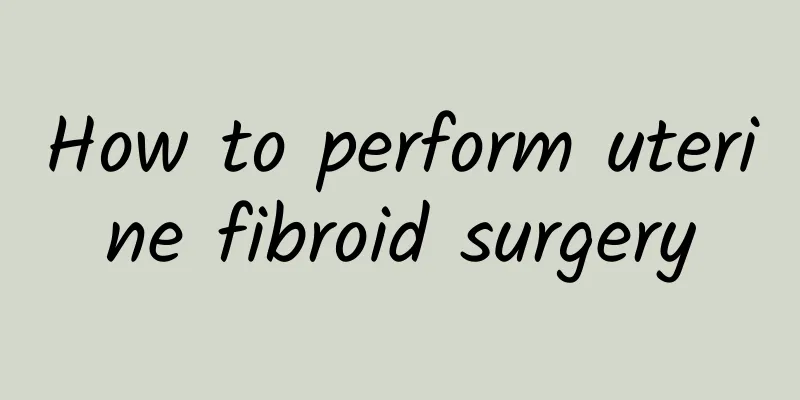How to perform uterine fibroid surgery

|
Uterine fibroid surgery generally selects the appropriate method based on the size, location, number of fibroids and the patient's physical condition, mainly including hysteroscopy, laparoscopy and laparotomy. The doctor will develop the best plan based on the patient's specific situation to relieve pain, protect fertility or completely cure the disease. Hysteroscopic surgery is suitable for patients whose fibroids are located under the endometrium, are small, and do not require hysterectomy. The hysteroscope is inserted into the uterine cavity to remove the fibroids, which has minimal trauma and fast recovery, but its scope of application is limited. Laparoscopic surgery is suitable for cases where the fibroids are large, numerous, or deep. It can remove a single fibroid or part of the uterine tissue. It is minimally invasive and has fast recovery. Open surgery is usually used for patients with fibroids that are too large, too numerous, or suspected of malignant lesions. It has a large operating field and a wide range of applications, but it is more traumatic and takes a long time to recover. A detailed assessment of the physical condition is required before surgery, including imaging examinations (such as ultrasound, MRI), blood tests, etc., and standardized management is also required during and after surgery. Hysteroscopic surgery is suitable for patients whose fibroids are located under the endometrium, are small, and do not require hysterectomy. The hysteroscope is inserted into the uterine cavity to remove the fibroids, which has minimal trauma and fast recovery, but its scope of application is limited. Laparoscopic surgery is suitable for cases where the fibroids are large, numerous, or deep. It can remove a single fibroid or part of the uterine tissue. It is minimally invasive and has fast recovery. Open surgery is usually used for patients with fibroids that are too large, too numerous, or suspected of malignant lesions. It has a large operating field and a wide range of applications, but it is more traumatic and takes a long time to recover. A detailed assessment of the physical condition is required before surgery, including imaging examinations (such as ultrasound, MRI), blood tests, etc., and standardized management is also required during and after surgery. After surgery, you need to rest and follow the doctor's advice on recovery. Avoid strenuous exercise and heavy physical labor in the short term. Eat a light diet and take more foods rich in protein and vitamins, such as lean meat, fish, and green leafy vegetables, to promote tissue recovery. Check regularly to monitor the recovery of the uterus and whether there are signs of recurrence. If you have symptoms such as abnormal bleeding and abdominal pain, you should see a doctor as soon as possible to avoid delaying treatment. |
<<: What causes Bartholinitis in women?
>>: What Chinese medicine is used for sitz bath for Bartholin's gland cyst
Recommend
Experts explain how to correctly prevent cervical hypertrophy
In real life, female friends are very likely to s...
On which day should I go for a checkup for abnormal leucorrhea?
If you find that abnormal leucorrhea persists for...
Can I eat before taking a blood test for ectopic pregnancy?
Can I eat before taking a blood test for ectopic ...
The glutton is possessed, and it’s hard to lose weight if you keep eating? Nutritionist’s 5 tips to control appetite!
Is your stomach growling again? With the arrival ...
Is it okay to have sex twice 25 days after a miscarriage?
Whether it is a big deal if you have sex twice wi...
How is pelvic inflammatory disease diagnosed?
I believe everyone is familiar with pelvic inflam...
Take a look at the common symptoms of cervical hypertrophy
What are the common symptoms of cervical hypertro...
How to treat adnexitis
Acute adnexitis is one of the types of adnexitis....
What medicine should I take if I have anemia and uterine fibroids? How can I take medicine if I have anemia and uterine fibroids?
What medicine should I take if I have anemia and ...
Will vaginal candidiasis affect pregnancy?
Will candidal vaginitis affect pregnancy? Will ca...
How is vulvar itching spread?
Vulvar itching is not a sexually transmitted dise...
Explanation of the causes of several easily overlooked adnexitis
There are many female patients with adnexitis. Am...
That one can also be very active! Create a 28-day jogging plan for yourself
Many women must have had similar questions: when ...
Is it normal to bleed after applying medicine for cervical erosion?
Cervical erosion refers to cervical columnar epit...
What harm does recurrent miscarriage cause? There are these 6 major harms
Abortion is very harmful to the body. If it is re...









